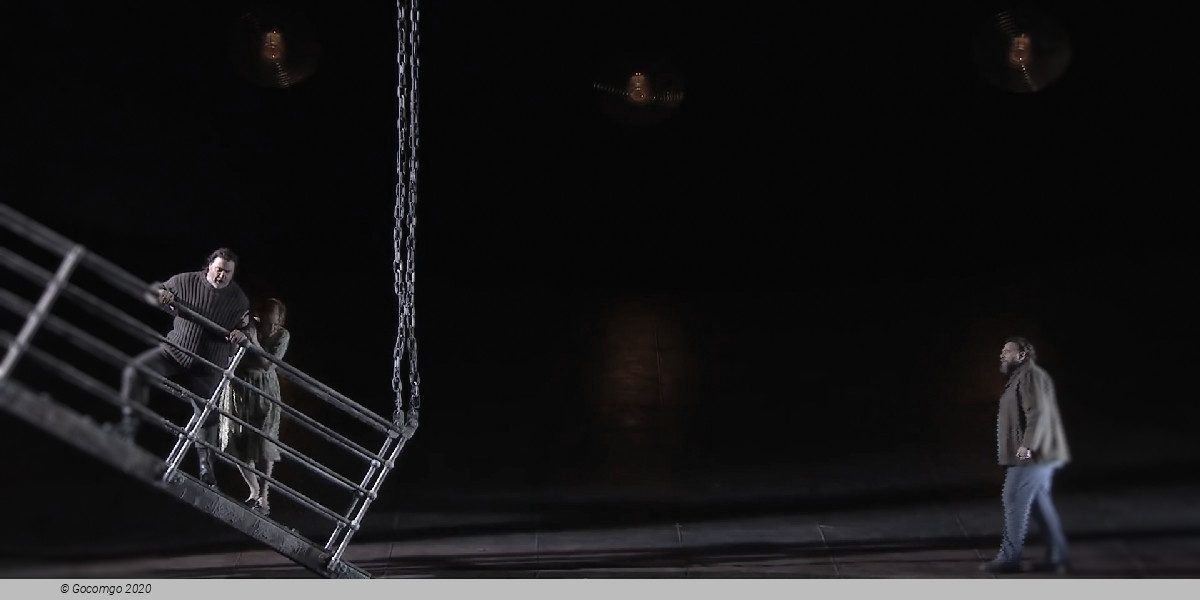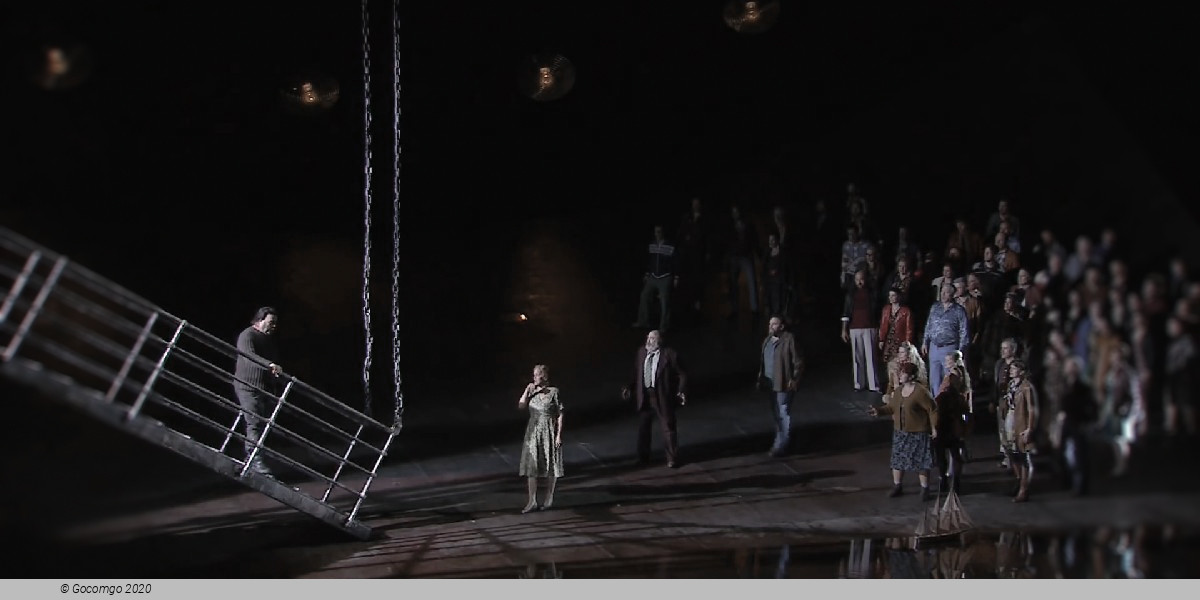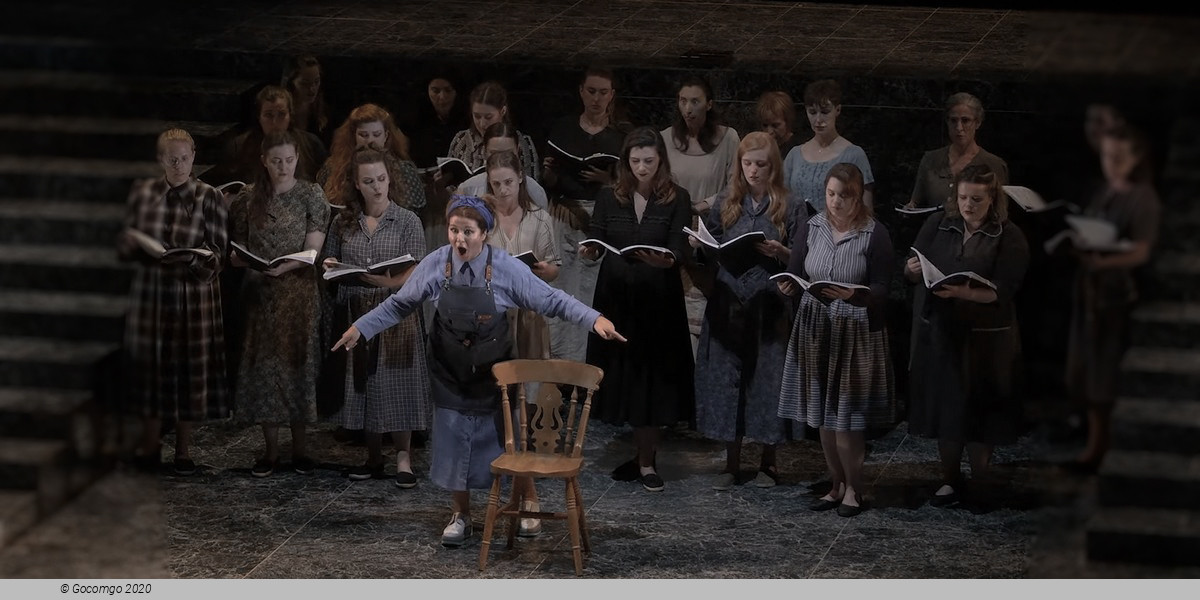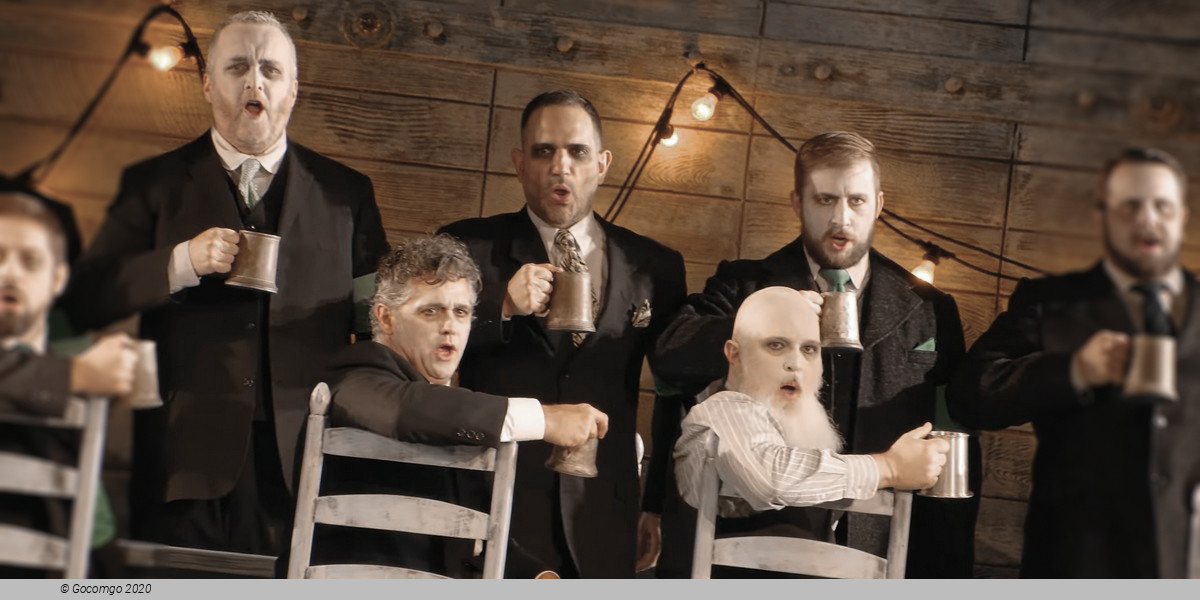Act One
The vessel of the Norwegian merchant Daland has run into a severe storm shortly before reaching harbour and drops anchor in the little cove of Sandwike on the Norwegian coast. Daland decides to wait for the storm to abate and sends the crew to get some rest. Only the steersman is left to keep watch on deck. He, however, is also soon overcome by sleep and does not notice the mysterious things which are happening around him.
A second ship approaches. The captain goes ashore. It is the Flying Dutchman, who bemoans his fate: he had once wanted to sail around a cape in a furious gale and sworn that he would accomplish this feat even if he had to keep on sailing forever. The devil took him at his word and condemned him to sail the sea until Judgement Day. The only hope he has of being saved from this terrible fate is if an angel were to intercede for him: every seven years the Dutchman can go ashore. If he manages to find a woman who will redeem him by promising to love him forever, the curse will be broken and he will be able to die.
Daland discovers the strange vessel and its captain. The Dutchman asks him if he might be his guest for a while. The merchant is happy to agree when he learns of the treasures this mysterious man offers him in return. He is also willing to give his daughter’s hand in marriage to the Dutchman when the latter asks his permission to woo her.
Meanwhile the storm has subsided and the wind has changed direction. The sails are quickly hoisted and Daland sails away, the Dutchman following him.
Act Two
Unlike the girls around her, Daland’s daughter Senta is absorbed in dreamy contemplation of the Flying Dutchman, whose portrait she has with her always. The girls tease her about this. Tired of listening to their silly teasing, Senta sings them the ballad of the Flying Dutchman, finally proclaiming that she is the woman who will deliver the condemned sailor from his curse with her love. At that moment Erik, who has loved Senta for a long time, enters. He brings news of the return of Senta’s father. The girls set off quickly to greet the sailors.
Erik pleads with Senta to ask her father for his consent to their marriage. She, however, tries to make him understand that the fate of the Flying Dutchman affects her more deeply than his pleas. As a warning, Erik tells her of his dream in which Senta meets a stranger, a weird sailor. Senta interprets this as a sign that her secret wish will be fulfilled.
Daland and the Dutchman enter. The father introduces his daughter to the stranger whose wife she is to become. He shows her the Dutchman’s treasures to convince her that she is making a good match. He then leaves the two of them alone.
Senta and the Dutchman are immediately attracted to each other and realise that they have each found the answer to their deepest longings in the other. Although the Dutchman warns Senta not to underestimate the sacrifice she is making for him, she is determined to become his wife and swears to be faithful to him until death.
Daland returns and invites them both to join in the celebrations with the sailors, at which he plans to announce Senta’s betrothal to the Dutchman.
Act Three
The Norwegians taunt the weird crew of the Dutch vessel, who do not want to take part in the celebrations. Finally the Dutch sailors retaliate, and everybody flees to escape the violence of their reaction.
Erik pleads with Senta but she does not respond to his reproaches. He reminds her of how she once said she loved him, which made him believe she would always be faithful. The Dutchman overhears this conversation and can no longer believe Senta truly means to keep her promise to him. Without giving her the chance to explain, the Dutchman turns to leave. In an act of despair, Senta confirms her pledge of fidelity.
Place: On the coast of Norway
Act 1
On his homeward journey, the sea captain Daland is compelled by stormy weather to seek a port of refuge near Sandwike in southern Norway. He leaves the helmsman on watch and he and the sailors retire. (Song of the helmsman: "Mit Gewitter und Sturm aus fernem Meer" — "With tempest and storm on distant seas.") The helmsman falls asleep. A ghostly vessel appearing astern is dashed against Daland's vessel by the sea and the grappling irons hold the two ships together. Invisible hands furl the sails. A man of pale aspect, dressed in black, his face framed by a thick black beard, steps ashore. He laments his fate. (Aria: "Die Frist ist um, und abermals verstrichen sind sieben Jahr" — "The time has come and seven years have again elapsed") Because he once invoked Satan, the ghost captain is cursed to roam the sea forever without rest. An angel brought to him the terms of his redemption: Every seven years the waves will cast him upon the shore; if he can find a wife who will be true to him he will be released from his curse.
Daland wakes up and meets the stranger. The stranger hears that Daland has an unmarried daughter named Senta, and he asks for her hand in marriage, offering a chest of treasure as a gift. Tempted by gold, Daland agrees to the marriage. The southwind blows and both vessels set sail for Daland's home.
Act 2
A group of local girls are singing and spinning in Daland's house. (Spinning chorus: "Summ und brumm, du gutes Rädchen" — "Whir and whirl, good wheel") Senta, Daland's daughter, dreamily gazes upon a gorgeous picture of the legendary Dutchman that hangs from the wall; she desires to save him. Against the will of her nurse, she sings to her friends the story of the Dutchman (Ballad with the Leitmotiv), how Satan heard him swear and took him at his word. She vows to save him by her fidelity.
The huntsman Erik, Senta's former boyfriend, arrives and hears her; the girls depart, and the huntsman, who loves the maiden, warns her, telling her of his dream, in which Daland returned with a mysterious stranger, who carried her off to sea. She listens with delight, and Erik leaves in despair.
Daland arrives with the stranger; he and Senta stand gazing at each other in silence. Daland is scarcely noticed by his daughter, even when he presents his guest as her betrothed. In the following duet, which closes the act, Senta swears to be true till death.
Act 3
Later in the evening, the local girls bring Daland's men food and drink. They invite the crew of the strange vessel to join in the merry-making, but in vain. The girls retire in wonder; ghostly forms appear at work upon the vessel The Flying Dutchman, and Daland's men retreat in fear.
Senta arrives, followed by Erik, who reproves her for deserting him, as she had formerly loved him and vowed constancy. When the stranger, who has been listening, hears these words, he is overwhelmed with despair, as he thinks he is now forever lost. He summons his men, tells Senta of the curse, and to the consternation of Daland and his crew declares that he is the "Flying Dutchman".
As the Dutchman sets sail, Senta throws herself into the sea, claiming that she will be faithful to him unto death. This is his salvation. The spectral ship disappears, and Senta and the Dutchman are seen ascending to heaven.


















 Max-Joseph-Platz 2
Max-Joseph-Platz 2